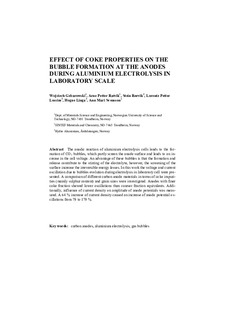| dc.contributor.author | Gebarowski, Wojciech | |
| dc.contributor.author | Ratvik, Arne Petter | |
| dc.contributor.author | Rørvik, Stein | |
| dc.contributor.author | Lossius, Lorentz Petter | |
| dc.contributor.author | Linga, Hogne | |
| dc.contributor.author | Svensson, Ann Mari | |
| dc.date.accessioned | 2017-11-20T12:21:00Z | |
| dc.date.available | 2017-11-20T12:21:00Z | |
| dc.date.created | 2017-06-01T16:22:27Z | |
| dc.date.issued | 2017 | |
| dc.identifier.citation | Light Metals. 2017, 2017 1203-1211. | nb_NO |
| dc.identifier.issn | 0147-0809 | |
| dc.identifier.uri | http://hdl.handle.net/11250/2467140 | |
| dc.description.abstract | The anodic reaction of aluminium electrolysis cells leads to the formation of CO2 bubbles, which partly screen the anode surface and leads to an increase in the cell voltage. An advantage of these bubbles is that the formation and release contribute to the stirring of the electrolyte, however, the screening of the surface increases the irreversible energy losses. The voltage and current oscillation due to the bubble evolution during electrolysis for different anode materials have been determined in a laboratory cell. The effect of coke sulphur content and grain sizes were investigated. Anodes with finer coke fraction showed lower oscillations than coarser fraction equivalents. Additionally, the influence of current density on the amplitude of the anode potentials was measured. A 64% increase of current density caused an increase of anode potential oscillations from 79 to 170%. | nb_NO |
| dc.language.iso | eng | nb_NO |
| dc.publisher | Springer Verlag | nb_NO |
| dc.title | Effect of Coke Properties on the Bubble Formation at the Anodes During Aluminium Electrolysis in Laboratory Scale | nb_NO |
| dc.type | Journal article | nb_NO |
| dc.description.version | submittedVersion | nb_NO |
| dc.source.pagenumber | 1203-1211 | nb_NO |
| dc.source.volume | 2017 | nb_NO |
| dc.source.journal | Light Metals | nb_NO |
| dc.identifier.doi | 10.1007/978-3-319-51541-0_144 | |
| dc.identifier.cristin | 1473591 | |
| dc.description.localcode | This is the pre-peer reviewed version of the following article: [Effect of Coke Properties on the Bubble Formation at the Anodes During Aluminium Electrolysis in Laboratory Scale], which has been published in final form at [https://link.springer.com/chapter/10.1007%2F978-3-319-51541-0_144]. This article may be used for non-commercial purposes in accordance with Wiley Terms and Conditions for Self-Archiving. | nb_NO |
| cristin.unitcode | 194,66,35,0 | |
| cristin.unitname | Institutt for materialteknologi | |
| cristin.ispublished | true | |
| cristin.fulltext | preprint | |
| cristin.qualitycode | 1 | |
